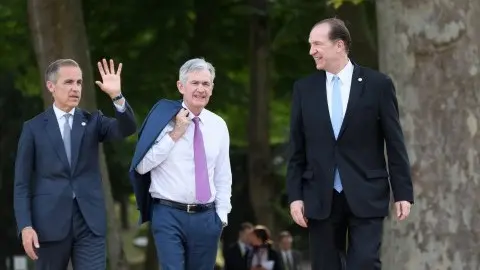US: Appetite to spend fuels 2Q GDP growth
Surging consumer and government spending offsets temporary weakness elsewhere, suggesting limited need for major Fed stimulus
| 2.1% |
2Q GDP growthdown from 3.1% but better than consensus |
Households and government underpin growth
GDP growth slowed in 2Q19 to 2.1% annualised from the 3.1% rate seen in 1Q19, but it was at least above the 1.8% consensus estimate. Moreover, the underlying story is better than the headline suggests given the huge swings in the inventory and the net trade components. Strip this out and we find real final sales to domestic purchasers grew an impressive 3.5%, which hardly suggests a desperate need for aggressive monetary policy stimulus.
Ever since President Trump kicked off the tariff war at the beginning of 2018 trade and inventories have been flying all over the place. US firms have been sucking in imports to avoid anticipated tariff hikes and then cut them as inventories became maxed out. In the second quarter net trade subtracted 0.65 percentage points from headline GDP after having contributed +0.73 percentage points in 1Q. Much of this was also due to weakness in headline exports, which underlines the legitimate concerns about global demand.
Likewise, inventories were liquidated in 2Q, subtracting 0.86 percentage points from growth after having been built up strongly for three consecutive quarters. This inventory run down can be attributed to the surge in consumer demand, which grew 4.3% annualised in 2Q. A strong jobs market, rising wages and asset prices and falling gasoline prices mean households had the confidence and the cashflow to spend.
Government consumption also surged – up 5% annualised. This reflects the rebound in spending after the late 2018/Jan 2019 government shutdown, which had depressed government spending over the previous two quarters.
Rounding out the report, fixed investment was weaker, falling 0.8%. Residential investment was down for the sixth straight quarter while non-residential was down after two consecutive 4%+ quarterly readings. However, we see some signs for optimism on this key component.
Contributions to annualised GDP growth (%)

Outlook remains positive
Firstly, the fact that inventories have been run down so aggressively means we won’t see a repeat in 3Q, thereby providing a strong platform for future growth. At the same time the household sector is fundamentally in strong shape while recent improvements in the housing market (rising sales and mortgage applications for home purchases in response to plunging mortgage rates) suggest residential investment may finally make a positive contribution.
The latest durable goods orders numbers, meanwhile, point to an improvement in 3Q non-residential fixed investment. As such something close to 2-2.5% growth looks achievable in 3Q19, particularly if US-China trade talks make progress – or we at least don’t see an escalation of tensions.
Our call: Just two Fed rate cuts…
Given that the volatility in trade and inventories had such a huge impact on both 1Q and 2Q19 GDP growth, we think it's better to look at the two quarters together. This gives an average rate of 2.6%, which is clearly very respectable. 3Q19 GDP growth also looks encouraging with recent data showing that the consumer sector is clearly in a good place while even manufacturing is showing renewed signs of life.
Nonetheless, the run rate for growth is slower than the 3% seen in much of 2018 and there is the threat that trade uncertainty will continue to act as a brake on activity. To combat this risk, we expect the Federal Reserve to pull the trigger on a precautionary 25bp rate cut next Wednesday with a further 25bp move likely in September.
The market continues to look for four rate cuts in total by the end of 2020, but we believe the catalyst for such action would have to be a significant ratcheting up in trade tensions. The key question is whether President Trump wants to go down this route. We assume he wants to go into next year’s election with the economy in the best shape possible. A positive boost to sentiment from a trade deal would help his re-election chances and would clearly reduce the need for any additional Fed policy easing.
Download
Download article
26 July 2019
In case you missed it: Worse and worse This bundle contains 10 ArticlesThis publication has been prepared by ING solely for information purposes irrespective of a particular user's means, financial situation or investment objectives. The information does not constitute investment recommendation, and nor is it investment, legal or tax advice or an offer or solicitation to purchase or sell any financial instrument. Read more
